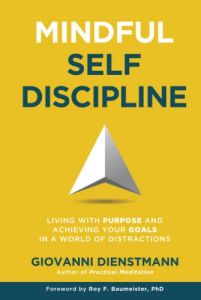Únase a getAbstract para acceder al resumen.

Únase a getAbstract para acceder al resumen.
Giovanni Dienstmann
Mindful Self-Discipline
Living with Purpose and Achieving Your Goals in a World of Distractions
Giovanni Dienstmann, 2021
¿De qué se trata?
Live your life in harmony with what you deem important, and focus on realizing your potential, goals and dreams.
Recommendation
Some people mistakenly believe self-discipline encourages self-shaming or imposes unwelcome restrictions on their lives. Meditation teacher and coach Giovanni Dienstmann aims to counter these misconceptions by extolling the virtues of mindful self-discipline. Cultivating self-discipline, he argues, improves your focus and well-being and gives you the personal power you need to achieve your goals. Dienstmann’s comprehensive three-pillar approach helps you uncover your true aspirations, gain self-awareness to overcome obstacles and start your journey.
Take-Aways
- Use the power of self-discipline to journey toward your goals without fear, doubt or distraction.
- Cultivate your aspirations by discovering your purpose – the “why” behind your goals.
- Once you realize your true aspirations, establish the “how” of achieving your goals by building self-awareness.
- Advance your aspirations with decisive action.
- Implement self-discipline in your daily life by integrating your activity with your aspirations and values.
Summary
Use the power of self-discipline to journey toward your goals without fear, doubt or distraction.
Self-discipline embodies more than just good habits, organizational prowess or time management proficiency; it is an essential life skill. Self-disciplined people possess the ability to find happiness and live a fully engaged life. When you learn the art of self-discipline, you acquire the capacity to navigate the distractions and busyness of life today and to achieve your future goals.
“Self-discipline is the art of living in harmony with your goals and values.”
To cultivate self-discipline, align your actions with your aspirations and acquire the power you need to achieve them. With self-discipline, you integrate the many virtues that enrich your life, such as growth, self-control, determination and optimism. You stay focused on your future, finish what you start, resist temptation and use your time well.
“Without self-discipline, the loftiest goal is just wishful thinking. With self-discipline, even a mediocre goal will take you somewhere.”
Think of self-discipline as the one life skill that gives you the power and ability to work toward your true aspirations. It helps you resist the diversion of temporary, fleeting enjoyment today at the expense of your future success and happiness. When you balance your ambitions with your expectations, you find a greater sense of self-acceptance and gratification.
Consider the benefits you gain with self-discipline:
- The ability to work through distractions and focus on activities that align with your goals.
- The ability to break your bad habits and develop good ones.
- Improved relationships with family and friends.
The three pillars of mindful self-discipline focus on the “why” (y0ur purpose), the “how” (your awareness) and the “what” (your actions):
- Discover your “why” by probing your true aspirations.
- Establish your “how” by building self-awareness.
- Plan your “what” and call yourself to action.
Cultivate your aspirations by discovering your purpose – the “why” behind your goals.
When you start a journey, you usually have a goal. For example, you begin a boat trip with a specific destination in mind, or you set personal goals to lose weight or to improve your work productivity. Your aspiration’s “deeper why” underlies that goal. For example, you want to lose weight to feel healthy and energized; or you want to improve your work output to highlight your skills and challenge yourself. While your journey’s destination represents your goal, your underlying purpose is why you want to get there.
“We all have a deep aspiration inside of us, waiting to be discovered, owned and realized.”
Start with your goals in mind, then take these seven steps to clarify your true aspiration:
- “Find your purpose” – Examine your core values and what you truly care about. Think about what inspires you the most, consider experiences where you felt your best or how you choose to spend your free time and money. Analyze a current goal and examine why you want to achieve it.
- “Magnify your purpose” – Measure the effects of both fulfilling or disregarding your aspirations in various areas of your life. Consider your family, your wealth, your career and your health.
- “Specify your purpose” – Further evaluate your aspirations with both quantitative and qualitative measures and create effective goals based on those measures. The SMART goal concept, for example, encourages you to design goals that are specific, measurable, achievable, relevant and time-bound. You generate more motivation when you set clear and attainable goals.
- “Prioritize your purpose” – Measure your goals against the resources you can commit – your time, money and energy. To truly follow through with your aspirations, you must give your goals the attention and time they need.
- “Resolve self-sabotage” – Recognize and resolve conflicting feelings you project toward your aspirations. For example, while you sincerely want to speak out more at work, part of you may fear judgment. Likewise, you may want to curtail your time spent on social media, but you fear missing out.
- “Cultivate your mind-set” – Take full ownership of your purpose and truly believe in your abilities to achieve. Trusting in yourself instills motivation and gives you the energy you need to grow.
- “Make your offering” – Decide what aspects of your personality hold you back and cause you to disconnect with your aspirations. For example, to increase your productivity, you need to stop sleeping late in the morning. To become fit, stop having that chocolate bar every day. Recognize and break the habits that will hinder your ability to achieve your goals.
Once you realize your true aspirations, establish the “how” of achieving your goals by building self-awareness.
Building self-awareness helps you establish how to move forward on your desired journey. Being self-aware provides you with the ability to choose. For example, if you want a healthy lifestyle, but recognize you love junk food, your awareness gives you the willpower to choose aspiration over temptation.
“[Awareness] gives you the freedom to choose how to respond to life as it happens, thus helping you live in alignment with your goals and values.”
Awareness also means you refrain from shaming yourself if you falter, since that invites a cycle of emotional stress and negativity. Choose instead to forgive yourself and recommit to your goal.
Practice three methods daily to help yourself build self-awareness and stay on track with your aspirations:
- Meditate at the start of your day to spark your awareness and clearly see what you need to do.
- Reflect – by journaling or tracking – at the end of each day to bring perspective and focus on how you aligned your emotions and your choices with your goals.
- Integrate your aspirations throughout the day with activity.
The PAW method – Pause, Awareness, Willpower – is an essential practice to help you fight impulses and distractions. It encourages you to stop and reflect before taking action:
- When you pause, you slow down and consciously think before acting on impulses – for example, when you encounter a conflict with your aspirations, such as eating junk food or smoking.
- Pausing provides you with the time and space to become aware of your choices. Do the available actions take you nearer to or further from your goals? For example, you hit the snooze button (further), eat a healthy lunch (nearer) and stop at the gym after work (nearer). Tally your score at the end of the day to see how well your choices reflect your intentions.
- Finally, use willpower, if needed, to intentionally shift your actions.
Apply the PAW method to overcome daily life’s obstacles, such as idleness, diversions and rationalizations. Pause and gain perspective by looking at your long-term goals. Connect emotionally to the version of yourself who follows through – who accepts temporary discomfort today in exchange for long-term success.
Advance your aspirations with decisive action.
Action requires effort and planning. Without a plan, you will be unlikely to move forward. Planning also uncovers how much effort it requires to advance your aspirations.
Take these four steps to plan your journey:
- Select one aspiration and one of its SMART goals.
- Establish separate tasks or milestones.
- Set start and end dates.
- Repeat for each goal.
Once you establish your milestones, design habits to strengthen your commitment. Your milestones may require action habits, such as writing in a journal or committing to daily meditation, or replacement habits that require you to introduce a new habit to replace a harmful one.
Effective habits are both specific and enjoyable:
- Specific habits describe the what, when and where of your activity. For example, if you set a goal to write a book, establish a habit not just to write every day, but to write a certain number of pages after dinner in your office.
- If you don’t enjoy the habits you set, you likely will abandon your commitment. Find a process you enjoy or can learn to enjoy.
To form habits, create effective cues that will prompt you to action. You likely already unconsciously respond to cues today. When your phone dings, for example, you pick it up. The smell of coffee prompts you to crave a cup. Cues also encourage negative habits. When you wake up feeling tired, you may snooze the alarm or when you see a pile of papers on your desk, procrastination likely kicks in. Creating purposeful habits requires that you set deliberate cues which inspire positive action.
Create a template with your cues and use your environment to prompt action: “When X happens, I will do Y.” For example, when you see your running shoes by the door, you will go for a run; when you see your journal on your bed, you will write in it before retiring; or when you get paid, you will plan your monthly budget. Until the desired action becomes automatic, give yourself a cue.
Just as cues are important for spurring action, so are rewards which will drive you to maintain those actions. Types of rewards include the following:
- Intrinsic rewards, which include enjoying the activity itself or the pleasure you get knowing it moves you closer to your goal.
- Extrinsic rewards, which include adding a pleasurable activity after your action, such as watching a movie after completing your chores.
- Painful consequences, such as losing something if you fail to do your activity.
Implement mindful self-discipline in your daily life that integrates your activity with your aspirations and values.
Consider effective ways to harmonize mindful self-discipline and your aspirations, such as time management, routines and meditation.
Managing your time wisely ensures your daily activities align with your aspirations. Successful time management, which mirrors the pillars of self-discipline, includes time prioritization and time awareness. Key elements include the following:
- Planning, which allows you to determine priorities and ensures you carry out your intentions.
- Setting boundaries by establishing what you will and will not do.
- Engaging time awareness to protect your schedule from getting off track.
- Focusing on your priorities and rebuffing distractions.
When you set and follow routines, you are more likely to adopt the fundamentals of mindful self-discipline. Begin with the morning and evening routines where you have more control. The morning routine prepares you for the day, while the evening routine offers a time to review and wind down. Both routines share common principles of a fixed start time and length, a structured set of habits, effective focus and an achievable set of activities.
“Self-discipline is a form of personal power. It’s the power to accomplish the goals you set for yourself and get things done… Use it wisely. ”
Meditation offers a superior method of awareness training and serves as a solid foundation upon which to build mindful self-discipline. Meditation also benefits your overall health and well-being. Several types of meditation exist, but all involve relaxation, focus and awareness. If you find one style of meditation decreases your passion and drive, try another method. You should focus on certain key areas when you incorporate meditation into your life:
- Habit – To reap the benefits of meditation, practice it every day.
- Technique – Choose the approach that best fits you and your lifestyle from among the many styles of meditation available.
- Transformation – Extend your meditation practice into your day by incorporating the ability to pause, reflect and manage your emotions.
Through mindful self-discipline, you enhance your virtues, or personal strengths – such as patience, courage, confidence and resilience – which you can then use to navigate everyday challenges. These virtues also boost your well-being. Make sure you balance your strengths to prevent them from becoming liabilities:
- Balance accountability with letting go to prevent being too hard on yourself.
- Balance self-belief with humility to prevent arrogance or recklessness.
- Balance perseverance with acceptance to avoid staying with something long after it loses its usefulness.
When you develop mindful self-discipline, you give yourself the power to understand your true aspirations and set yourself on a journey to accomplish anything you want to achieve.
About the Author
Giovanni Dienstmann is a best-selling author and speaker who advocates for improving your life through self-discipline and meditation. He coaches and teaches meditation at schools, hospitals and spiritual centers.
This document is restricted to personal use only.
























Comment on this summary